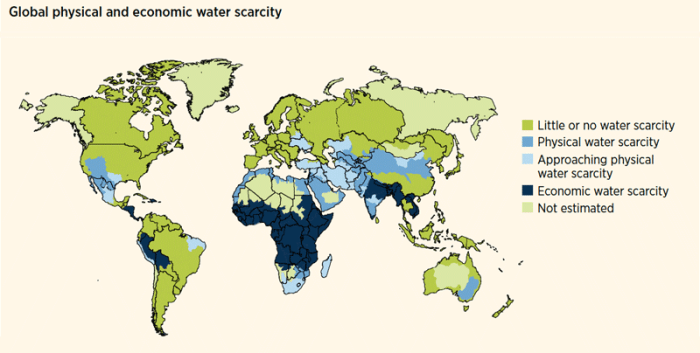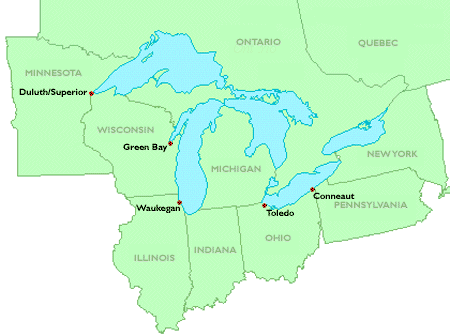
Source: World Water Development Report 4. World Water Assessment Programme (WWAP), March 2012. Image via the United Nations
By Zoltan Grossman via The Evergreen State College, Olympia, Washington
With diminishing water supplies and rapid human population growth, communities and countries are being prompted to investigate alternative water resources. Water pipelines have been a proposed, but controversial option. These massive pipelines pump water from a large source and transfer it across a great distance to areas in need. This webpage will investigate the positives and negatives of water pipelines, the conflicts they introduce, potential pipeline projects, and existing pipelines worldwide.
Purpose of Water Pipelines
The purpose of water pipelines is to transport surface water or groundwater from one area to another without causing erosion and reducing the chance of evaporation. Water pipelines are large in diameter and can supply water to communities and industries over both short and long distances. Pipelines can be installed underground or above ground. They can be used to bring in freshwater, or to transport and dispose of wastewater.
Water Shortages: Pipelines as a solution?
With the world population reaching 6 billion and counting, the need for water is growing. Only 2.4% of all water on Earth is freshwater, and less than 1% of all freshwater is available for human use. There is no question that water is absolutely necessary for human survival. However, over one billion people on Earth already do not have access to a clean water supply. With a growing population, this number will drastically increase, especially as we continue to abuse, pollute, and deplete our current supplies.
Potential Pipeline Projects
The Great Lakes Basin is vast source of water, containing 20% of the world’s surface freshwater, and 95% of U.S. surface freshwater. Pipelines have been discussed and proposed to share the water from this massive watershed to both nearby cities and suburbs, and also extending thousands of miles west and southwest. In the 1980’s, there were proposals to pipe Great Lakes water to the southwest, but were dismissed due to the costliness, difficult logistics, and strong objections from Great Lake states. As water continues to be overused and depleted in the western and southwestern states through agricultural, industrial, and domestic uses, potential pipeline proposals are not out of the question. The lakes contain enough water to supply millions of people with water.
Read the entire report here.
Categories: Conservation, Economics, Education, Environment, Environmental policy, Human ecology, Natural resources, Politics, Science, Technology, Water quality

You have to read it to figure out if the US needs to build 2,600 plus miles of water pipeline to 7 drought stricken US states.
LikeLiked by 2 people
This is an important issue. We live on the “water planet,” yet water as one of the most fundamental necessities of life is in increasingly short demand for a growing portion of the human population. It has been rightly called the “new gold.”
I was fascinated by this post for another reason entirely. I was once a student in the environmental science program at The Evergreen State College, where the author, Zoltan Grossman, is currently a faculty member.
LikeLiked by 2 people
Everyone calls water the new gold and I have heard that statement for years. Even corporations know this yet it is not being worked on. One has to wonder why this is the case.
I remember when we cleaned up our water by protesting when I was young in my small town. Our All American Town was dumping sewage in our river. The children including me was swimming in that river down river. The entire school even protested. We finally called the EPA which made it more costly to dump raw sewage but today that is just a fine.
Remember when we had the 99% protest which was mostly ignored or worse, so they went underground. We have let corporations take over and get too powerful. I am not sure how we can solve our water issues. I wish I did because I am seeing the damage even in our oceans.
We have got to figure out a way to solve problems again like we did in the past. Water is our life blood, the planets life blood, and our future.
LikeLiked by 1 person
I’m not a big fan of trying to re-engineer the Earth. There are too many historic precedents. It rarely turns out well. Here are a few links concerning the diversion of naturally flowing freshwater sources to supply human needs:
The Aral Sea Crisis–Columbia University
Facts about Glen Canyon Dam–Grand Canyon Trust
Problems with the Aswan Dam–Penn State
China Has Launched the Largest Water-Pipeline Project in History–The Atlantic
Draining the ecosystems of the Great Lakes to water golf courses in Arizona… Why are we building golf courses in the desert?
This just makes me sad: The Colorado River Runs Dry–The Smithsonian Institute
And then there is this: ‘The Last Bit of Paradise’: Giant Dam Threatens Brazilian Rainforest–Der Speigel
You see? They taught me pretty well at The Evergreen State College. Lol.
LikeLike
If countries and people are not going to practice birth control, (which even in the US is much harder to achieve) than potable water is a necessity. Without it there is resulting conflict and chaos. Current history show us this remarkably well in Africa and the Middle East because of drought.
Using ocean water isn’t much different. There is a limited amount of water on earth. Any time an ecological system is overburden, be it human or not, there are consequences.
The allocation of water to drought stricken areas can be done with well thought out plans and implementation of same. The error is in not thinking about consequences. Using water for golf courses is one that isn’t well thought out nor a good use of resources.
This all hinges on population growth or not the world over. Water is necessary for the food supply chain. Be it cattle, to corn, to rice. Either eventually, the population will be controlled by a lack of either one or both.
In the meantime, the US could work on a long range plan to be twofold, keeping the food supply chain enabled and have potable water available to any drought area while keeping in mind the consequences to the ecological system.
But that requires legislators that write well thought out legislation and engineering, not something they are well known to do but they have done it, once in awhile.
LikeLiked by 1 person
Great comment, Ecantados. Indeed, drought driven by climate change has been cited as a primary cause of the Syrian uprising. In Iraq, ISIS has been fighting for control of the Tigris and Euphrates watersheds. And the Assad regime has used the withholding of water to contested areas as a weapon of war against opposition strongholds. Likewise, in Israel and the occupied Palestinian territories the rationing of water supplies and the destruction of old Palestinian wells continues to be used as a means of economically subjugating the Palestinian people.
But too many poor strategies are at play in the United States. Using fossil water from diminishing aquifers to irrigate corn for ethanol production is an obvious one. Expanding urban development in desert areas is another
LikeLike
Palestine finally got dragged into the 21st century with water. They’re committed to building a desalination plant. Though, their sewer infrastructure does more to contaminate their aquifers than using the water to the last drop. One reason that Israel is so adamant about destroying buildings that aren’t properly structured to an existing sewer plant. They’ve long known or at least some that they needed to spend more money on the sewer/water infrastructure.
Poor strategies, that’s being nice to how Congress is ignoring the obvious…heh.
The thing about corn, whether used for cattle, chickens, or ethanol is of growing concern from what little I’ve found. All three are water intensive farming methods. The US has been a bit lucky in that where the majority of the corn is grown has kept sustainable levels of water. The same cannot be said for cattle.
LikeLiked by 1 person